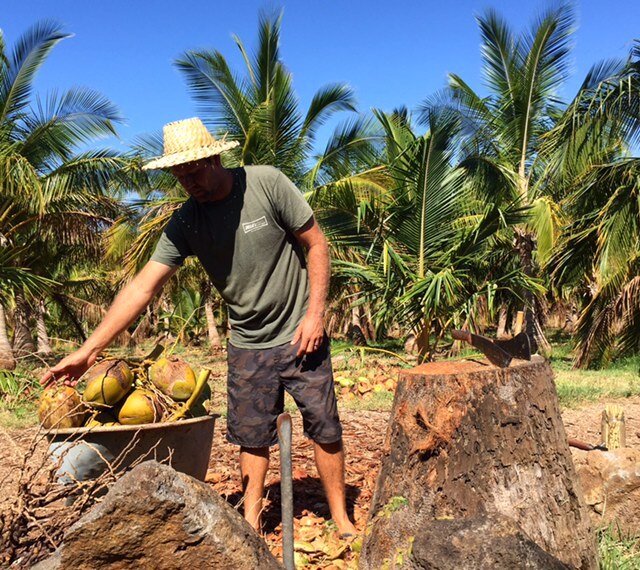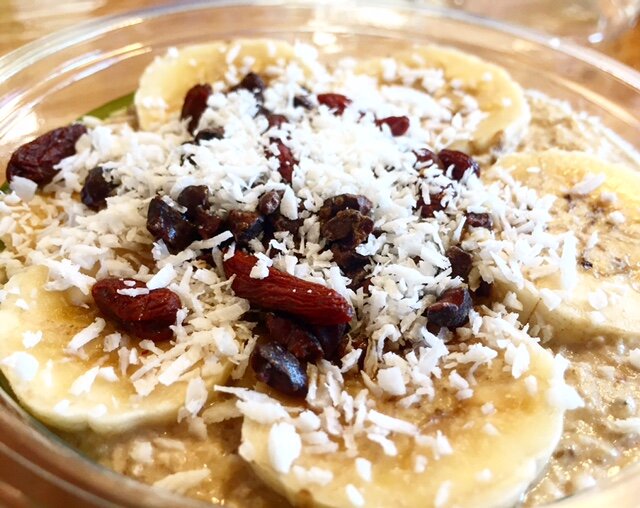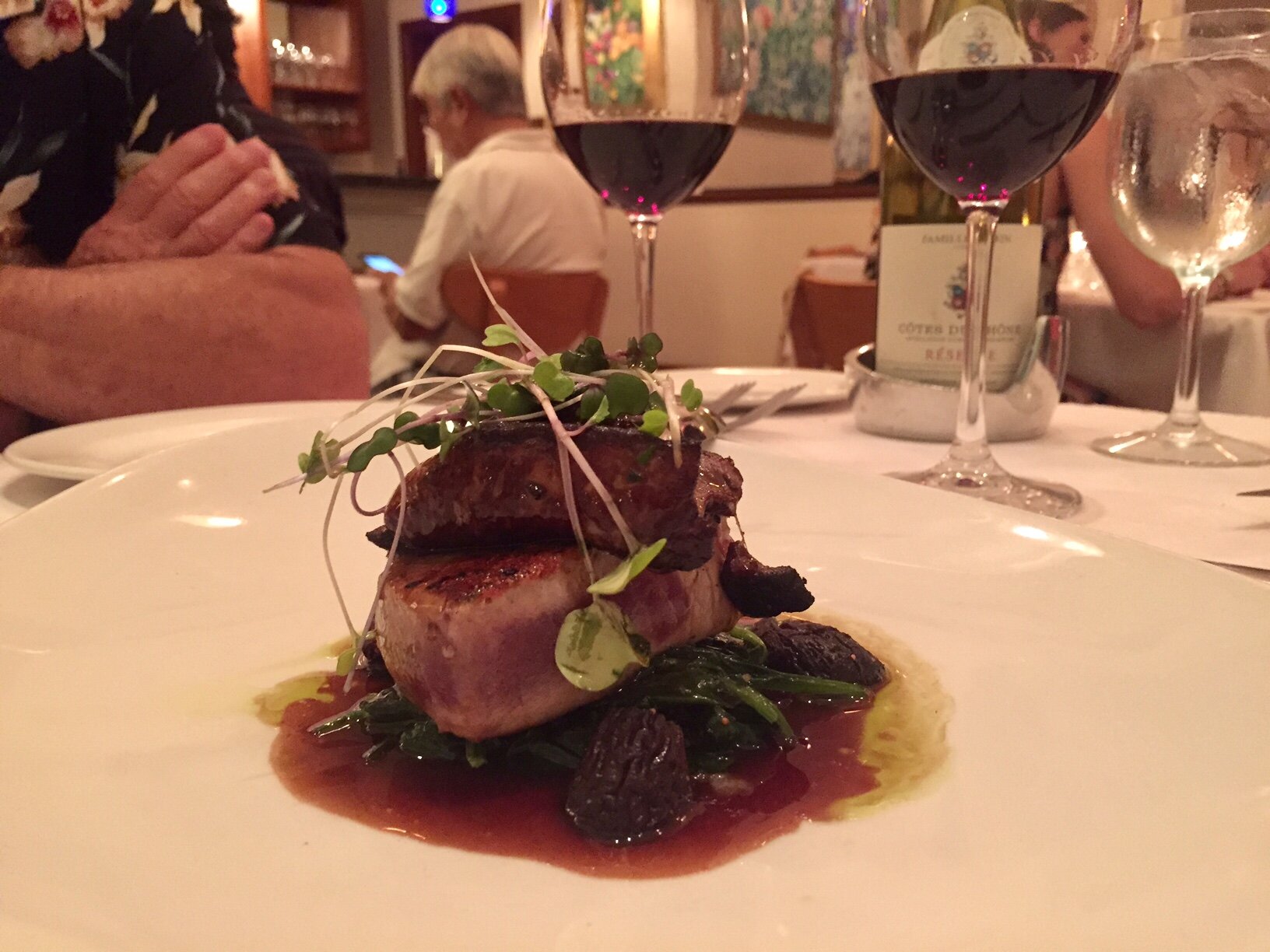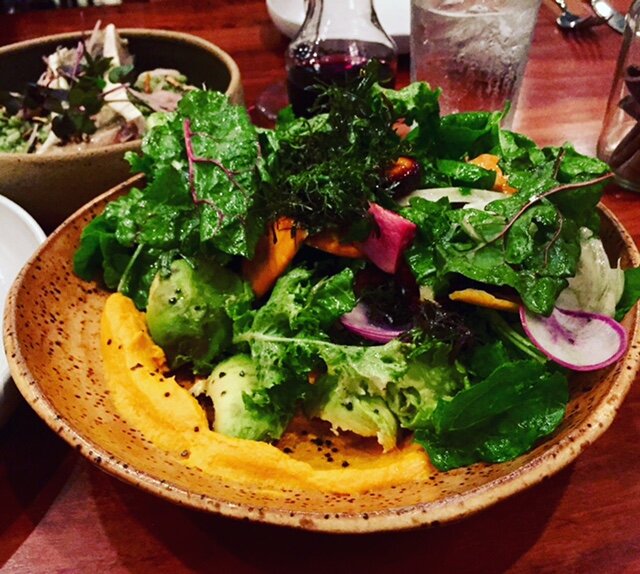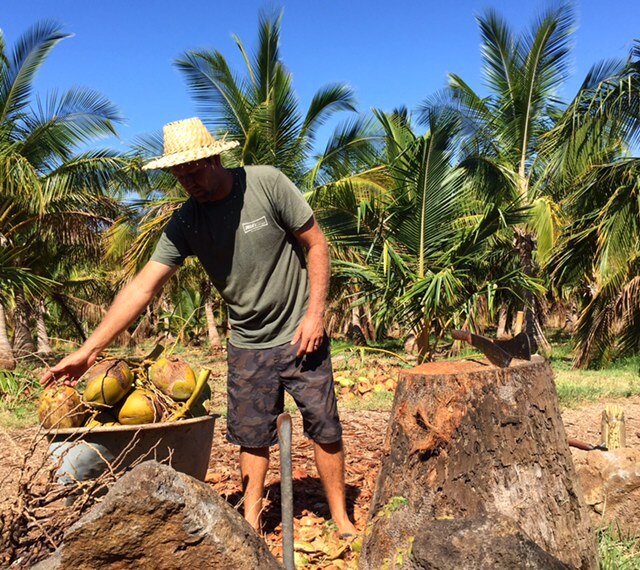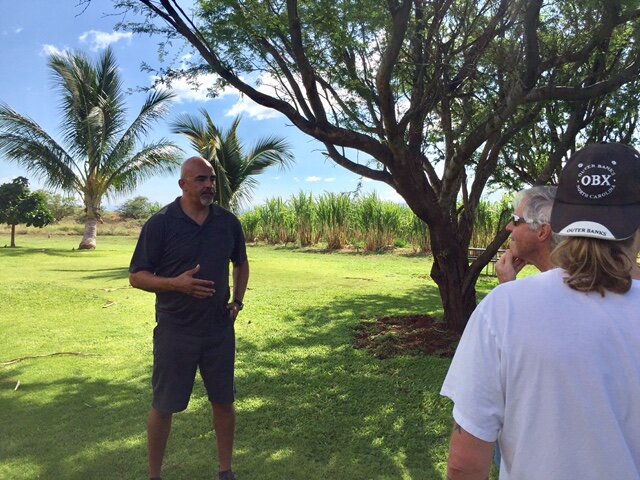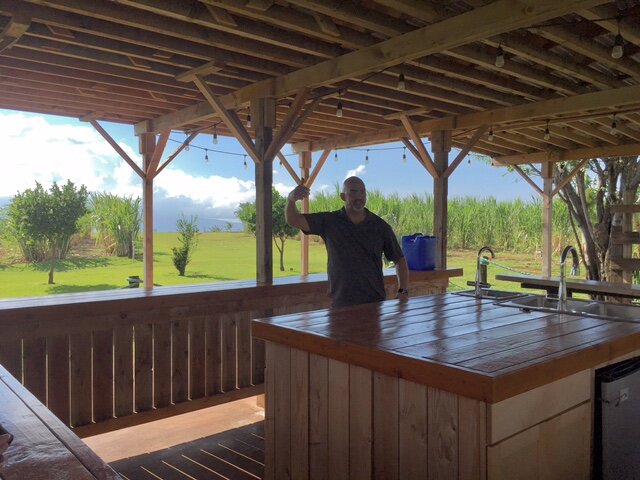The road to Hana is paved with…….not enough restaurants!
Sure, there is world class snorkeling, humpback whale watching, and the infamous road to Hana. But if you are a chef or a foodie like me, you plan your trips around food and squeeze those things in only if there is extra time!
If you find that ludicrous, then this particular travel guide is not for you. There will be no beach recommendations or ocean excursions mentioned here. There will, however, be a boatload of restaurants, farms, and places to get a good drink nestled in this post.
If you are coming over from Honolulu and landing at Kapalua airport chances are good you’ll be arriving in a puka shell sized puddle-jumper such as this one. I recommend flying into this airport, to avoid the hoards of tourists at the bigger and busier Kahului Airport located on the other side of the island.
But be prepared, other than a tarmac and a glorified hot dog stand you won’t find any amenities at this airport. Have a ride lined up or you’ll be walking to your hotel. Rental cars are a must have on this island.
Lahaina
The original capital of Hawaiʻi. The towns up and down the west side of Maui, including Lahaina, are no doubt some of the most picturesque on the island. Large banyan trees, beautiful beach parks, and views of Lana’i and Moloka’i line the coast.
We opted for an oceanfront Airbnb at the Kaleialoha Vacation Rentals for our accommodations. It was a cute little one bedroom with beach access, spacious lanai, and fully stocked kitchen. There was a sea turtle that swam around below us every morning.
Airbnb in Lahaina
View from our Kaleialoha vacation rental
Places to eat near Lahaina
Choice Health Bar
This is a great place to stop for a healthy vegan breakfast, lunch, or a non-alchololic and sugar free beverage. All of the produce used on the menu here is organic and handpicked locally. Menu selections include things like overnight oats, chia pudding, pad thai, kale and quinoa buddha bowls, acai bowls, smoothies, and shots of noni juice.
Overnight oats at Choice Health Bar
Merriman’s Kapalua
When you are ready for pau hana and an epic sunset, cruise over to Merriman’s and grab a spot at the bar overlooking Kapalua Bay. Peter Merriman is one of the founding fathers of Hawaiʻi Regional Cuisine and helped pioneer the farm-to-table concept here. 90% of the food at this restaurant is locally sourced. And they make a damn good mai tai .
Merriman’s Lahaina
Lahaina Grill
If you are craving classic, old world inspired cuisine and are having a foie gras void in your life (like I was), then this is where you come. It’s not cutting edge but it is decadent. Think escargot, Wagyu beef ravioli with black truffle, filet mignon and lobster. I recommend ordering a few things to share for the table and a nice glass of wine and leave it at that. This place can get pricy.
Marcho Farms Veal “Osso Buco” at Lahaina Grill
Seared Ahi and Hudson Valley Foie Gras at Lahaina Grill
The Mill House
Hands down my favorite restaurant on the island.
Tucked inside the Maui Tropical Plantation through a path of botanical gardens and fountains made of old sugarcane cogs, you will find one of the most beautiful restaurants on Maui. And the best part? They farm the majority of their produce on site. The rest all comes from other parts of the island. Everything including the unbelievable table bread – such as buttery Hawaiian dinner rolls and rustic sourdough – to the delicate pastas are made in house. Hats off to chef Jeff Scheer.
Local Fish Crudo & Mortadella Musubi at The Mill House
Chicken Bao Buns & Pork Shank Rillette at The Mill House
Greens and root vegetables from the farm with carrot puree and lemon vinaigrette
Local fish, coconut-cucumber curry and spicy papaya salad
Bone Marrow with Braised Taro Leaf Risotto at The Mill House
Chocolate mousse and banana ice-cream with candied cashew at The Mill House
Punakea Palms
Just a man and his coconuts….
On the surface it would appear that Punakea Palms sells farm tours. But, after taking a tour here I know now, that what they are actually providing is an educational experience in natural farming, sustainability and the health benefits of coconut.
This is a family owned and run operation. In fact, the owners live on the property, so what you are basically taking is a tour of their back yard.
The owner’s son, Kai, is the mastermind behind the coconut groves here. He is both the farmer and the tour guide. Kai starts the tour by giving you some background on the land you are standing on – old sugarcane fields with soil that has been heavily depleted from hundreds of years of burning the land to harvest sugarcane.
Kai and his family aren’t growing coconuts to sell (there is surprisingly not a big enough market and coconut products are too labor intensive to be profitable), they are trying to save the land.
There are a few methods they use to do this: They grow a legume called halloa to add nitrogen, which nourishes the soil by providing the dry, scorched land with moisture. They water the palms with nutrient dense water from the valley and they have planted pine trees on the property to encourage more rain. They are helping to restore the ecosystem of the land back to the rainforest it once was before being turned into sugarcane fields.
Kai explains that coconut palms are indigenous to Hawaiʻi and were the first trees to sprout up when the islands were first being formed by volcanos. They require a warm tropical climate with lots of rain, about 20 gallons of water everyday to be exact. He said that the coconuts themselves act as seeds. They fall from the tree and with sun and moisture they set roots and sprout up.
Kai at Punakea Palms
From here, Kai explains harvest times and how to check what stage the coconut is in when picked.
At 5 months or less the coconuts are not ready. The water is a bit sour and the meat is underdeveloped, like jelly.
At 6 months the coconuts are young and the meat is starting to firm up.
Prime harvest time for coconut water is 7 months. The coconuts will be heavy and when shaken you will hear water sloshing around inside of it. The meat at this point is the perfect texture to scrape out and eat with a spoon.
If making coconut milk is what you desire than you wait until the coconuts are firm, dry and light in weight.
As we sat on the grass under a shady tree (which you will need to take advantage of, since it gets very hot on this farm) Kai cracked coconuts and continued to educate us while we sipped fresh coconut water from bamboo straws.
Water fresh from a coconut is a flavor you will never find in any bottled version. Even if the brand uses non-heated methods for pasteurization.
Kai also dispelled the myth that pink coconut water occurs in nature. Apparently it is only a result of pasteurization.
Making fresh coconut milk at Punakea Palms
Kai finishes the tour by teaching the group some of the ways to process coconuts for eating and drinking. He’ll show you how to use a traditional coconut stool shredder to grate the meat out of mature coconuts. You’ll also get to try your hand at using a more modern coconut meat removal tool to carve out the meat to make coconut milk with.
Making coconut milk is a surprisingly simple, yet labor intensive process, that involves carving out the meat from a mature coconut, pureeing it in a blender with a mix of coconut water and filtered water and then squeezing it through a nut bag.
The milk that comes out is rich and delicious and will last up to 4-5 days in the fridge. The coconut meat that you capture in the nut bag, by straining off the milk, can be dried and made into coconut flour.
Kahului
This is the city where the bigger airport is located.
Tin Roof
If you are a foodie, no trip to Maui is complete without a stop to the infamous Tin Roof, owned by Chef Sheldon Simeon
You may remember him from Top Chef season 10 and 14. He is also on tap to host the new season of the YouTube show Cooking in America this fall.
His menu is a playful take on your typical Hawaiian plate lunch restaurant. He of course uses local meats, fish, produce and artisan-made products and prides himself on making honest food for his community.
His Mochico chicken is addictive. Crunchy and tender, glazed with a sweet sauce, furikake and asian rice crackers. The Pork belly is succulent and flavorful. Sides include things like spicy kale salad, ‘ulu mac salad, saimin noodles that you can get dry or with broth and what is called a dime bag (I’ve heard rumors on what people think this is. Some say it is a mixture of crumbled up rice crackers, doritios, furikake and spices.
Save room for dessert because they carry Pono Pies! Ridiculously good vegan and gluten-free pies made with breadfruit. I tried the banana-coconut cream version and it was amazing.
Heads up these guys are only open 10am-2pm, they’re closed on Sundays and there is probably going to be a long line.
Actually, do yourself a favor, if you are flying out of the Kahului airport. Stop here first to get some ono flight grinds!
…and don’t forget to throw down a few bucks for the Pau Hana Fund. (That’s the cash pot for after work beers for all you civilians.)
Mochico chicken, Saimin, Pork Belly, Mac-Ulu Salad and Banana-Coconut cream Pono Pie from Tin Roof
Banana-coconut Pono pie
Upcountry
No foodie trip to Maui is complete without a tour of upcountry. As you drive out to the countryside away from the coast climbing up Haleakala crater to the center of the island you will find farms rich in volcanic soil, stunning views, and paniolos (Hawaiian cowboys).
Paʻia
Paʻia is where upcountry starts farthest north by the coast. It is a quaint little hippie, surfing town full of great dining options, an excellent organic health food store called Mana Foods, and lots of boutique shopping right on the edge of one of the best windsurfing beaches in the world.
Milagros
If you’re only in town one night grab dinner at Milagros. A mom and pop establishment serving some of the best Mexican food in Hawaii (believe me, in Hawaii it’s hard to come by). Grab a margarita and some enchiladas, or fish tacos, out on the lanai and let the people watching commence.
Makawao
This is known as cowboy country. In the days of King Kamehameha III he sent vaqueros (Spanish cowboys) from California to come and teach the Hawaiians how to wrangle their cattle. Up until WWII this town provided supplies to neighboring farms, and went all but dormant until a resurgence in the 80’s brought in upscale retail, yoga studios, and hip eateries….and of course, there is a cowboy museum too.
T. Komoda Bakery
Legendary bakery specializing in donuts, dinner rolls, and their famous cream puffs. Locals say get there early. Past 10 or 11am they just about sell out of everything.
Hali’imaile
This tiny town is only a few miles long and is mostly made up of a few must-see businesses…
Hali’imaile Distilling Company
Home of Pau Vodka made from pineapples grown right across the street and other spirits made from locally grown ingredients. Tours run every hour.
Hali'imaile Distilling Company
Haliʻimaile General Store
We have had the cookbook for this restaurant sitting on our bookshelf for years. The food is highly regarded here, but what is equally impressive is their cocktail menu. Ask for Wendy, who has been bartending there for 17 years. The first bartender I have ever met whose favorite tool behind the bar is a blender. She has constructed an entire menu of blended libations. She uses local spirits (some distilled just across the street), fresh herbs, fruit and lots of love in every drink she makes. She’ll even make up a new one right there on the spot for you if you’d like. Be on top of your game, she’s got some good zingers you’ll miss if you aren’t paying attention.
The Lemongrass-Ginger Frost at Hali’imaile General Store
Makai Glass
Take a free tour of a glassblowing studio. Sculptures are inspired by Hawaiʻi sea life and volcanic formations and are incredibly beautiful.
Makai Glass
Maui Pineapple Tour
Learn how pineapples are grown, harvested, and processed. There will be pineapple to sample and even bring home. This is a pretty famous attraction on the island so book your tour in advance.
Kula
Positioned on the slopes of the Haleakala crater – a dormant volcano and the second largest mountain in the world – is the town of Kula. Miles of pristine farmland boasting some of the most beautiful panoramic views of the ocean that you will find on the island.
Ali’i Kula Lavender Farm
A wonderland of over 7 varieties of lavender broken up by walking trails, gazebos and zen gardens. Farm tours are available daily.
Maui Wine
Pineapple wine? Yep, and many other interesting varietals as well. Sip on exotic wines as you enjoy the beautiful vineyard and breathtaking views.
Surfing Goat Dairy
I love the story of this place. Thomas and Eva, husband and wife team from Germany, were a couple of surfers who came to Maui to “retire.” Over 9 years later they own the only certified humane goat farm in Hawaiʻi – one of only two goat farms in the entire state – and make award winning goats cheeses that have found their way on to menus all over the country including, at the White House (the variety, Utterly Delicious was served at President Obama’s inauguration).
They raise about 200 goats by hand. They are completely self sufficient in terms of energy (Hawaiian Sea Spirits is the only other farm on Maui that can say that). Their whole farm is decorated with broken surfboards that they rescued from becoming landfill at the dump (they traded the county goat cheese for them).
Their cheeses are light and mild. Pasteurization, done immediately after the milking process, removes any gamey flavor the goat’s milk could impart. They offer 30 different variations of goat cheese including a cheve that sits in rennet 24 hours, and aged cheese called ping pong and over the top varieties like “Midas Touch” (dusted with 23k gold flakes) and “Perigord” (covered in black truffles and truffle oil.).
My personal favorites were their feta and the Ole, which is flavored with jalapeños, artichokes, lime and cilantro.
Not to mention the goats are damn cute. I loved that they had a special pen for the female goats that were too old to milk anymore called “The Golden Girls Caralle.”
Hawaii Sea Spirits
You gotta love a farm that offers you free food right off the bat as you walk in. Of course I helped myself to some bananas and of course they were delicious.
This is Earl, an ex-bartender and the distillery’s entertaining and extremely knowledgable tour guide. He walks you through the USDA certified organic farm filled with varieties of sugarcane from all over the world and the distillation process, then concludes the tour with a tasting.
Hawaiian Sea Spirits Organic Farm & Distillery tour
Our tour guide, Earl at Hawaiian Sea Spirits Organic Farm & Distillery
The distillery is known for two premium spirits. Master distiller, Bill Scott has created Ocean Vodka and Deep Island Hawaiian Rum, both crafted in a state of the art eco-friendly facility using sugarcane grown organically on the property.
As you tour the grounds you will be invited by lush, colorful landscaping.
They make a 150 proof white rum that has nuances of banana, coconut, vanilla and marshmallow.
While Rum is defined by its ingredients, vodka is defined by its distillation process.
Earl explains that they first mix the sugarcane with distillers yeast for three days until it ferments. They then take that 10% alcohol “sugarcane beer,” heat it and distill it until it reaches 40% alcohol. This is now called a “sugarcane spirit”. For the vodka, they distill it 40 times until it is super clean. From here they blend the spirit with their very clean and fresh ocean mineral water. This water is part of their claim to fame. It started as a glacier in Greenland. Over the span of 2000 years the world’s current carried it to Kona Hawaii, where it is then tapped into 3000 feet below sea level and brought to Maui to their farm.
Since the only things that matter for the quality of vodka are water, fermentation. and distillation Hawaii Sea Spirits has vowed to nail all three.
Sugarcane
The “bar” at Hawaiian Sea Spirits Organic Farm & Distillery
Back at the bar Earl pours shots for everyone. The vodka is slightly sweet, doesn’t burn going down, and actually enhances the other ingredients when mixed into a cocktail.
He explains that their ,rum unlike most other rums, is made from fresh sugarcane juice and not molasses. It has not been aged or spiced and because of that is completely clear in color. It smells like coconut and tastes like banana bread.
O’o Farm
Organic farm that produces all of the produce Pacific’o restaurant in Lahaina serves on its menu. Their farm tour includes a gourmet lunch with freshly harvested ingredients while enjoying a cooler climate with breathtaking views.
Enjoy Maui! It is delicious!
And all foodie obsessions aside, no trip to Hawaiʻi is complete without a trip to the beach. So enjoy some good food, quality time with your friends and family, and take an afternoon nap by the ocean…. island style.

